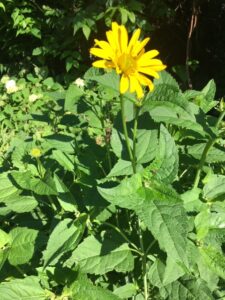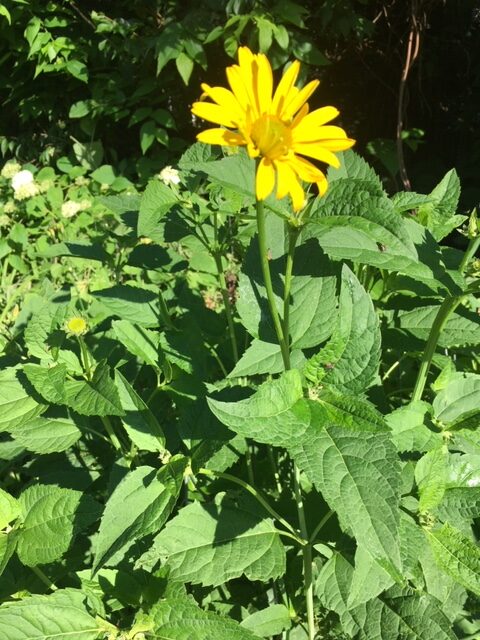June 15th
The 166th Day of the Year
Instinctively summer is accepted as the normal condition of the earth, winter as the abnormal. Summer is ‘the way it should be.’ It is as though our minds subconsciously returned to some tropical beginning, some summer-filled Garden of Eden.
Edwin Way Teale
Sunrise/set: 5:06/8:05
Day’s Length: 14 hours 59 minutes
Average High/Low: 82/61
Average Temperature: 71
Record High: 96 – 1897
Record Low: 47 – 1933
Weather
Temperatures remain hot most of the time: four years in ten bring highs in the 90s, and five in ten bring 80s. Cool temperatures in the 70s or 60s share the remaining ten percent. The heat may contribute to making today one of the three June days most susceptible to a thunderstorm (the 2nd and the 20th are the other two). Rain falls 55 percent of the time. After the showers, the sky clears up eight years in ten.
The Weather of the Week Ahead
The likelihood of rain diminishes this week of the year, and the period brings at least four days that historically are favorable for field work. Chances of completely overcast conditions decline to less than 20 percent. The 16th, 17th, and 18th have a very low incidence of rainfall (just 20 percent chance of showers), and chances on the 21st are only 30 percent. Two days this week are often rainy; however, today and 20th have better than a 50 percent chance of thunderstorms. Temperatures are usually warm, with only 35 percent of the afternoon highs remaining below 80 degrees. Hot 90s occur at least 20 percent of the time. Lows are in the 60s the majority of nights, but 50s and 40s occur up to 40 percent of the time.
The Natural Calendar
As Early Summer deepens, the days are the longest of the year, and mulberries and black raspberries are sweetest. Milkweed beetles look for milkweed flowers on the longest days; giant cecropia moths emerge. The first monarch butterfly caterpillars eat the carrot tops.
Damselflies and daddy longlegs are everywhere in brambles along the rivers when mulberries and black raspberries come in. Mosquitoes, chiggers, and ticks have reached their summer strength in the deep woods. Long, black cricket hunters hunt crickets in the garden.
Two out of three parsnips, angelicas and hemlocks are going to seed. Multiflora roses and Japanese honeysuckles are dropping petals. But wingstem and tall coneflower stalks are five feet high. Virginia creeper is flowering. Canadian thistles and nodding thistles are at their best. Blackberries have set fruit. The very first trumpet vines sport bright red-orange trumpets, and the first yuccas, Deptford pink and first great mullein come into bloom.
Daybook
1982: Hail fell today in a storm, some up to an inch in diameter.
1983: First firefly.
1984: At Wilberforce, chicory is finally open. South Glen: Most white-flowered waterleaf is suddenly gone. Seed clusters have formed on the Jack-in-the-pulpit, and white violets are disappearing. First moneywort seen, first tall meadow rue. Timothy is sweet and tender. There are bud clusters on the milkweed. Some parsnips have rusted, gone to seed. Geese seen with big fat goslings. Small box turtle on the woods path. Buds on the touch-me-nots. Brown seeds falling from the small flowered crowfoot. Wild ginger still in bloom. Young woodchuck, frightened by my approach, climbed a tree to escape me, hung there above my head like a raccoon.
1986: Red berries on the King Street honeysuckles now.
1988: Very last strawberries from the garden eaten today, and a dozen black raspberries. First firefly came out tonight, delayed by the drought.
1990: Cherries and mulberries ready for pies. My mouth waters, and I am excited.
1993: Most garden daisies in Yellow Springs and most hawthorn flowers are past their prime. The wild thin-leafed daisies in the pastures, however, are still in full bloom. Full bloom of coreopsis throughout town. First carnations open, first chicory and Queen Anne’s lace blossoming along the southern highway, first catnip on Dayton Street, first tall blanket flower in the south garden. Yellow tiger swallowtail in the pink sweet Williams. Daisy fleabane under the cherry tree is in full bloom. Peppermint found along the high path at Clifton Gorge, has been out for weeks, beginning to fade. Large patches of fire pink along that walk, and orange poison ivy flowers.
1995: St. Louis to Salina, Kansas, heading west towards Columbia, Missouri: The roadside vegetation remains relatively stable, generally “Midwestern” (a week or two ahead of Yellow Springs) with Queen Anne’s lace, yellow and white sweet clover, crown vetch, daisy fleabane, yellow and white moth mullein, dogbane, milkweed, chicory, white bindweed in full bloom. Huge compass plant, four to six feet tall, seen near Columbia and beyond. Into Kansas, the landscape changes quickly, the number of trees and clovers dwindling, and the vegetation becoming predominantly grasses. The green of the wheat starts to pale as we drive west, and crops were still being planted throughout the Plains.
1998: Queen Anne’s lace opens. Neysa reports tadpoles swimming in the water at the Alhambra in Granada, Spain.
2002: First yellow daylilies coming in. Big blue hosta blooms. The first pale-leafed Japanese iris and the first lizard’s tail blossoms in the pond.
2003: First Frances Williams hosta, first big blue hosta, first Heliopsis, first red lilies flowered today.
2004: The first purple coneflower is opening in the north garden today. They have been blooming at the Women’s Park for about a week. Mallow now in full bloom, and lilies gathering momentum. Oakleaf hydrangea anchors the northwest corner of the garden with its white flowers. Hollyhocks are out throughout the village. Kousa dogwood flowers disappearing in the triangle park.
2007: Blue jays feeding their young in the back yard today – grackles, sparrows, robins and jays all with fledglings in the second week of June.
2008: Red-bellied woodpecker called early in the morning. The first mallow opened overnight. The first wild orange lily and the first chicory seen on the way from Clifton. At Clifton Gorge, honewort was going to seed, clustered snakeroot mostly gone to seed, a few white waterleaf flowers (most gone), berries on Solomon’s plume, just a few white violets left, some fire pink seen in bloom.
2009: To Santee in South Carolina: Hemlock all to seed below Cincinnati. Trumpet creeper in bloom near Lexington, Kentucky. Mimosa trees blooming from central Kentucky south. At Santee, maybe a hundred miles from Charleston, the corn was tall and lush, ears fully formed, the first time in several years the crop has looked so good when we arrived in middle June. Watermelon festival announcement heard on the radio. We have driven down into the middle of Yellow Springs July. Heal-all blooming along the dock, mayflies everywhere, especially at dusk. Two geese with four fuzzy goslings (boot-size) swam by a little after 8:00.
2010: First avens seen flowering in Mateo’s yard and in the alley this morning. First mallow opened in the north garden, and a few monarda blossoms are developing. Very last primrose by the roses. Trumpet creeper vine seen in full bloom along Dayton-Yellow Springs Road this afternoon. Storms in the night, the yard soggy, standing water in some the properties along Dayton Street.
2012: Yucca drooping now, Stella d’oros past their peak. All Don’s pie cherries gone. Monarda reaching early bloom. Primroses hold full.
2013: Spoleto, Italy: The fragrance of jasmine in full bloom fills the entire city, has been growing stronger and stronger since I arrived at the end of May. Behind Neysa and Ivano’s studio, a small pie cherry tree is full of cherries that are getting soft. There have been no birds here to eat them. Beside the cherry, a persimmon tree with small fruits about half the size of an acorn. Ivano said that the fruit is ripe after all the persimmon leaves have fallen in the autumn.
2014: Snow-on-the-mountain almost completely seeded now. The first ditch lilies (Hemerocallis fulva) coming into bloom at Petty’s and Moya’s, the latest I think I have recorded the start of their season. Heliopsis seen full early bloom as I drove down Corry Street. At South Glen: Leafcup budded, honewort aging, lush jewelweed, wood nettle dominating the forest floor, getting ready to flower (nettle and honewort sharing the landscape, the rough and the delicate), aging violet-flowered waterleaf, a daisy fleabane, a few scattered sweet rockets. Pales moths flutter from the foliage as I pass. At home, only two cabbage butterflies, two blues and a glimpse of a black swallowtail.
2015: In the middle of days of heat and rain, the annuals surge. The first orange tithonia (sprouted up in the attic during February) opened in last night’s storm. Webworms are crawling around in their webs on Peggy’s cherry tree. The castor bean has grown a foot in 48 hours. The reluctant amaranth and the hesitant zinnias no longer hold back. Eleven clumps of lilies in bloom: mostly Stella d’oros, ditch lilies, rebloomers and trumpet lilies. One blue chicory seen on the way to Beavercreek, drifts of Canadian thistles fresh and pink, a few more great mulleins.
2016: Walking with Emily from 6:30 in the North Glen, robins and cardinals and doves and house wrens filling the air as I walked out of the house. At the Glen parking lot, I heard a screech owl, and when Emily arrived, she found it in her binoculars, and I saw my first one, so blue in the trees. As we made the loop around the yellow spring, we heard green frogs, and many different birds including chipping sparrows, Carolina wrens, red-bellied woodpeckers, pileated woodpeckers, chickadees, indigo buntings, pee-wees, a red-shouldered hawk and we got close to an Acadian Flycatcher – my very first. Its call was so distinct, a firm and sharp two-note song. In the undergrowth, moneywort was in full bloom near the river. Honewort was going to seed. One ragwort still had a few flowers. Along the road south to Xenia, some hemlock already gone to seed, new bright birdsfoot trefoil, banks of crown vetch, parsnips nodding.
2017: Thirty-three ditch lily blossoms, forty-three Stella d’oros, seven Asiatics, four everbloomers. A few cabbage whites, a handful of small bumblebees with legs gold with pollen. The purple coneflowers in the northwest garden are barely starting to unravel. Several Osage fruits have fallen to the sidewalk from the wind and rain. Small black beetles with black wings flying near the porch. In the countryside, the wheat is a rich orange brown. A long patch of nodding thistles in bloom, some to seed, past Fairborn. The lawns are white with clover now, and the great blue-leafed hostas are in full bloom.
2018: Tree crickets buzzing all around today. The red admiral has come for a second day of sugar water from the hummingbird feeder. And around 10:00 this morning, I saw my first female Eastern black swallowtail of the year, shyly moving in and out of the honeysuckles. Another swallowtail seen briefly this afternoon. The birds seem quieter today, far less of the frantic chirping and scrawing of the past few days.
2019: Only three Stella d’oro lilies open today, no others in the garden. On Davis Street, we found the yucca plant in full flower. Buckeyes on the tree near the grade school are the size of a marble. From Madison, Wisconsin, Tat sends a photo of a large turtle laying eggs near the lake and said she saw one crossing the road about ten days ago.
2020: Thirteen Stella d’oros today, nine deep purple pond iris. When I was cutting back bamboo near the south wall, I surprised a sizable grass snake that had a fat, male American toad halfway in its mouth. Late in the day, the first heliopsis opened almost all the way.
On earth and only on earth are sunset glow, green leaf, and eyes to see them. Here is all we know of reality, all-sufficient to our destiny, our thoughts and passions.
Donald Culross Peattie\


